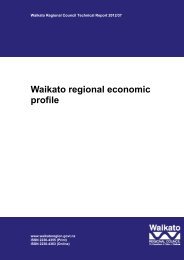Opuatia Peat Bog Management Plan - Waikato Regional Council
Opuatia Peat Bog Management Plan - Waikato Regional Council
Opuatia Peat Bog Management Plan - Waikato Regional Council
Create successful ePaper yourself
Turn your PDF publications into a flip-book with our unique Google optimized e-Paper software.
Removal of the grey willow canopy allowed a lot more light into this vegetation<br />
type. As a result a large number of saplings are present. A large proportion of<br />
these are grey willow, with lesser amounts of manuka, swamp coprosma and<br />
alder. Other pest plants common in this vegetation type, particularly in the<br />
north of the wetland, include yellow flag iris, reed sweetgrass, and reed canary<br />
grass. The invasive royal fern (Osmunda regalis) was found in low numbers at<br />
several locations along the eastern margin.<br />
7. Manuka scrubland<br />
Manuka dominates the canopy of this vegetation type. Before the willow control<br />
operation the more northern areas of this vegetation type had large amounts of<br />
grey willow in the canopy which has now been killed.<br />
The understorey is comprised of tall tangle fern (Gleichenia dicarpa), Baumea<br />
teretifolia, and swamp kiokio with very occasional mounds of Sphagnum moss.<br />
Swamp coprosma, mingimingi, Dianella nigra and gorse (Ulex europaeus) are<br />
present on the fringes. Wire rush (Empodisma minus) is common where the tall<br />
manuka canopy has become sparser on the edges of the peat bog.<br />
Deer tracks were observed widely within this vegetation type. Patches of forked<br />
sundew (Drosera binata), and the native ground cover Nertera scapanioides are<br />
present along these tracks.<br />
8. Manuka-Baumea teretifolia-tangle fern-wire rush shrubland<br />
This vegetation type is similar in composition to manuka shrubland, the<br />
difference being that manuka is of lesser height, and Baumea teretifolia, tangle<br />
fern and wire rush are more common in the canopy.<br />
9. Gorse-beggars’ tick-tangle fern shrubland<br />
The willow control operation appears to have induced several new vegetation<br />
types on the inner wetland fringe of the control area. On the western margin,<br />
this vegetation type is dominated by the pest plants gorse and beggars’ tick,<br />
although the indigenous tangle fern was also common. Several other annual or<br />
short lived perennial species that require open habitat aree also present including<br />
Australian fireweed (Senecio bipinnatisectus), American fireweed (Erechtites<br />
hieraciifolia), fleabane (Conyza sumatrensis) and Juncus planifolius.<br />
<strong>Peat</strong> <strong>Bog</strong> Vegetation Types<br />
<strong>Peat</strong> bogs are typically nutrient poor, poorly aerated, and very acidic, with the water<br />
table close to, or just above the ground surface (Johnson and Gerbeaux 2004). Water<br />
supply is typically from precipitation only, but at <strong>Opuatia</strong> the bogs appear to be very<br />
occasionally (approximately every 15 years) inundated with floodwaters when<br />
flooding in the <strong>Waikato</strong> River backs up into the <strong>Opuatia</strong> Stream. As a consequence<br />
these bogs are less acidic than is normally the case.<br />
© 2011<br />
12<br />
Contract Report No. 2621

















